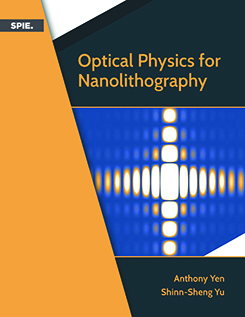This book is written for anyone who wishes to learn the underlying physics of imaging in photolithography applied to the fabrication of integrated circuits. While it is our desire to
present the beauty of this physics, the fundamentals of which were established more than 140 years ago yet the applications of which still flourish, the objective here is to present the
fundamentals of optical physics to lithography engineers coming from diverse fields with no or little background training in this subject. Our desire is to level the playing field, so to speak, with
the hope that, after studying the book, they are better prepared to do cutting‐edge work.
Over the past five decades, progress in the fabrication of integrated circuits has been made possible largely by advances in photolithography - the patterning technology whereby circuit
patterns are formed in the photo‐sensitive‐material‐coated semiconductor wafer, by reduction-imaging of larger versions of them on the mask delineated nowadays by beams of electrons. As
these projection‐imaging tools called scanners continue to be refined (through the reduction of the operating wavelength, increase of the numerical aperture with continual refinement of the
imaging optics, and continuous improvement in mechanical precision and accuracy), finer and finer images have been patterned on the wafer. High‐volume manufacturing of the 28‐nm
generation of logic integrated circuits is accomplished by scanners operating at the 193‐nm wavelength and employing water‐immersion optics. The same technology has been extended to
the 10‐nm generation by patterning it multiple times when defining a single physical layer of the integrated circuit. Starting with the 7‐nm generation, the world will see a switch to a new
wavelength at 13.5 nm in the soft x‐ray or extreme ultraviolet (EUV) region of the electromagnetic spectrum. EUV scanners used in high‐volume manufacturing are the most
precise instruments in the world.
Building on the inherent capabilities of scanners, lithography engineers have been advancing photolithography's practical resolution in integrated‐circuit manufacturing by increasing the
usable depth of focus and by mitigating such issues as linewidth variation between dense and relatively isolated lines, foreshortening of line ends, and distortion of feature shapes, commonly
referred to as proximity effects, to name just a few. Therefore, our goal here is to better prepare our readers for the difficult tasks of extending this practical resolution by applying our
knowledge of optical physics.
We start Chapter 1 with a few important mathematical topics needed for the rest of the book. Chapter 2 starts with a deductive introduction of the fundamentals of electromagnetism,
culminating in Maxwell’s equations and the solution of the generalized wave equation, a preparation for Chapter 5. In Chapter 3, we first discuss Maxwell's equations in material media
and then go on to examine the generation of electromagnetic waves (with the help of Hertz vectors) and the microscopic description of reflection and refraction, and end with a discussion
on reflection and transmission of light incident on a multilayer stack. In Chapter 4, we digress to discuss geometric optics whose many powerful but simple results are essential for
understanding projection imaging. Chapter 5 is devoted to the theory of diffraction in both scalar and vector formulations. Chapter 6 deals with the theory of imaging with its various
formulations and (computation‐wise) efficient approximations. Imperfections in imaging systems are the subject of Chapter 7, which starts with a description of Seidel aberrations and
concludes with a detailed derivation of the Zernike polynomials from the first principles.
We endeavor to include several pedagogical "innovations" in this book. First of all, we make copious use of mathematics and are concise with our words, for we believe physics is best
described using the language of mathematics. To enhance the reader’s comprehension, we include detailed intermediate steps in all derivations. However, in order to not disturb the flow,
these detailed derivations are printed in blue. We also make use of colors other than black to mark more complicated mathematical derivations. The reader may find them useful or be
reminded to skip them at the first reading.
These notes are a refined and substantially expanded version of the original hand‐written material delivered in weekly evening lectures by the first author for the good part of the year
2012. He wishes to express his gratitude to Dr. Burn Lin for his support of the project. He also acknowledges the heavy debt owed to Born and Wolf's Principles of Optics (referred to as B&W
in these notes), which was assigned as the primary reference book to accompany the lectures. Finally, the authors would like to thank SPIE Press for their dedication and effort in improving
the presentation of the text and its timely publication.
Anthony Yen
Shinn‐Sheng Yu
January 2018



